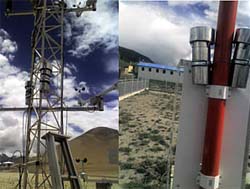
Passive samplers are installed at local meteorology or hydrology stations so that they are avoided from anthropic interference and with effective management.
With an objective of assessing the spatial distribution of persistent organic pollutants (POPs) across Qinghai-Tibet Plateau by means of passive samplers, Dr. WANG Xiaoping and her colleagues from the CAS Institute of Tibetan Plateau Research have been conducting a project entitled "the Qinghai-Tibetan Atmospheric Passive Sampling (QTAPS)." The establishment of the QTAPS network, including 19 sites mainly in background locations, costs the team one-year hard work. By taking advantage of the network, Dr. WANG has carried out studies on POPs in the snow and atmosphere around Mt Qomolangma.
This network includes four transects. Line 1 includes nine stations along north-south transect (Golmod-Amdo-Nagqu-Namco-Lhasa-Xigaze-Lhaze-Tingri-Zhangmu) and Line 2 consists other four stations along another north-south transect (Yushu-Qamdo-Rawu-Yayü). There are two east-west transects involved in this network. That is Zhongba-Lhaze-Xigaze-Lhasa-Gongbogyamda-Nyingchi-Bomi-Rawu (Eight stations) and Gar-Gệrzệ-Amdo-Nagqu-Qamdo (Five stations). The location of the stations covers major part of the Plateau and various climate types. Experts say that it is conducive for them to map the spatial distribution of persistent contaminants across the Plateau and investigate the relationships between the spatial distribution and the relative composition of POPs and further study the effects of climate change and monsoon bloom on the distribution and source age of POPs.
Although the global-scale and long-time survey of the concentration of POPs in air by passive samplers has been widely employed in the world, it is their first time to be introduced into the Qinghai-Tibetan Plateau. And yet data on pollutant concentrations in atmosphere are scarce and the extent of impacts is unknown. There is, therefore, an urgent need to assess contamination status across the Tibetan Plateau. Via long-term studies at the QTAPS network, it is expected to evaluate the impact of the long-range atmospheric transport of POPs on the Plateau environment. Besides, the research itself will reveal the influence of the local climatic pattern and seasonal monsoon on the transport, storage and sequestration of POPs.
.





